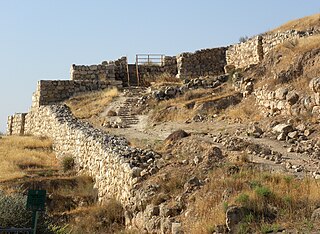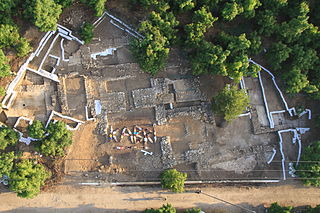
Tel Aviv-Yafo, often referred to as just Tel Aviv, is the most populous city in the Gush Dan metropolitan area of Israel. Located on the Israeli Mediterranean coastline and with a population of 467,875, it is the economic and technological center of the country. If East Jerusalem is considered part of Israel, Tel Aviv is the country's second most populous city after Jerusalem; if not, Tel Aviv is the most populous city ahead of West Jerusalem.

Lachish was an ancient Canaanite and Israelite city in the Shephelah region of Israel, on the south bank of the Lakhish River, mentioned several times in the Hebrew Bible. The current tell (ruin) by that name, known as Tel Lachish or Tell ed-Duweir ,, has been identified with the biblical Lachish. Today, it is an Israeli national park operated and maintained by the Israel Nature and Parks Authority. The park was established on lands of the depopulated Palestinian village of Qobebet Ibn ‘Awwad which was north of the Tel. It lies near the present-day moshav of Lakhish.

Tel Aviv University is a public research university in Tel Aviv, Israel. With over 30,000 students, it is the largest university in the country. Located in northwest Tel Aviv, the university is the center of teaching and research of the city, comprising 9 faculties, 17 teaching hospitals, 18 performing arts centers, 27 schools, 106 departments, 340 research centers, and 400 laboratories.

Tel Megiddo is the site of the ancient city of Megiddo, the remains of which form a tell, situated in northern Israel near Kibbutz Megiddo, about 30 km south-east of Haifa. Megiddo is known for its historical, geographical, and theological importance, especially under its Greek name Armageddon. During the Bronze Age, Megiddo was an important Canaanite city-state and during the Iron Age, a royal city in the Kingdom of Israel.
Timnath-heres or Timnath-serah, later Thamna, was the town given by the Israelites to Joshua according to the Hebrew Bible. He requested it and the people gave it to him "at the order of the Lord". He built up the town and lived in it.

Israel Finkelstein is an Israeli archaeologist, professor emeritus at Tel Aviv University and the head of the School of Archaeology and Maritime Cultures at the University of Haifa. Finkelstein is active in the archaeology of the Levant and is an applicant of archaeological data in reconstructing biblical history. He is also known for applying the exact and life sciences in archaeological and historical reconstruction. Finkelstein is the current excavator of Megiddo, a key site for the study of the Bronze and Iron Ages in the Levant.

Benjamin Mazar was a pioneering Israeli historian, recognized as the "dean" of biblical archaeologists. He shared the national passion for the archaeology of Israel that also attracts considerable international interest due to the region's biblical links. He is known for his excavations at the most significant biblical site in Israel: south and south west of the Temple Mount in Jerusalem. In 1932 he conducted the first archaeological excavation under Jewish auspices in Israel at Beit She'arim and in 1948 was the first archaeologist to receive a permit granted by the new State of Israel. Mazar was trained as an Assyriologist and was an expert on biblical history, authoring more than 100 publications on the subject. He developed the field of historical geography of Israel. For decades he served as the chairman of the Israel Exploration Society and of the Archaeological Council of Israel. Between 1951 and 1977, Mazar served as Professor of Biblical History and Archaeology at the Hebrew University of Jerusalem. In 1952 he became Rector of the university and later its president for eight years commencing in 1953.

David Ussishkin is an Israeli archaeologist and professor emeritus of archaeology.

Yosef Garfinkel is an Israeli archaeologist and academic. He is Professor of Prehistoric Archaeology and of Archaeology of the Biblical Period at the Hebrew University of Jerusalem.
Yohanan Aharoni (7 June 1919 – 9 February 1976) was an Israeli archaeologist and historical geographer, chairman of the Department of Near East Studies and chairman of the Institute of Archaeology at Tel-Aviv University.

The Yarmukian culture was a Pottery Neolithic A (PNA) culture of the ancient Levant. It was the first culture in prehistoric Syria and one of the oldest in the Levant to make use of pottery. The Yarmukian derives its name from the Yarmuk River, which flows near its type site of Sha'ar HaGolan, near Kibbutz Sha'ar HaGolan at the foot of the Golan Heights. This culture existed alongside the Lodian, or Jericho IX culture and the Nizzanim culture to the south.

Abu Kabir was a satellite village of Jaffa founded by Egyptians following Ibrahim Pasha's 1832 defeat of Turkish forces in Ottoman era Palestine. During the 1948 Palestine war, it was mostly abandoned and later destroyed. After Israel's establishment in 1948, the area became part of south Tel Aviv. Officially part of Giv'at Herzl, the adjacent Jewish neighborhood, the name Abu Kabir continued to be used. Part or all of Abu Kabir was officially renamed Tabitha by the Tel Aviv municipality in 2011.

Tel Kabri, or Tell al-Qahweh, is an archaeological tell containing one of the largest Middle Bronze Age Canaanite palaces in Israel, and the largest such palace excavated as of 2014. Kabri is named for the abundance of its perennial springs the presence of which has led to the site's occupation and use as a water source from the Pottery Neolithic (PN) period to the present day. Located in the Western Upper Galilee, the site was at the height of its power in the Middle Bronze, controlling much of the surrounding region. Kabri declined as a local power at the end of the Middle Bronze, but the site continued to be occupied at times, on a much reduced level, up until the 1948 Arab-Israeli War.
Sennacherib's Annals are the annals of the Assyrian king Sennacherib. They are found inscribed on a number of artifacts, and the final versions were found in three clay prisms inscribed with the same text: the Taylor Prism is in the British Museum, the Oriental Institute Prism in the Oriental Institute of Chicago, and the Jerusalem Prism is in the Israel Museum in Jerusalem.

Ephraim Stern was an Israeli archaeologist and professor at the Hebrew University of Jerusalem. He specialized in the archaeology of ancient Israel and Judah and Phoenicia, and was known for his excavations at Tel Dor (1980–2000).

Tel Aviv Pride is a week-long series of events in Tel Aviv which takes place on the second week of June, as part of the international observance of Gay Pride Month. The key event, taking place on the Friday, is the Pride Parade itself which attracts over 250,000 attendees. As of June 2019, it is the largest LGBT Parade in Asia.

Oded Lipschits is an Israeli professor in the Department of Archaeology and Ancient Near East Studies at Tel Aviv University. In 1997 he earned his Ph.D. in Jewish History under the supervision of Nadav Na'aman. He has since become a Senior Lecturer and Full Professor at Tel Aviv University and served as the Director of the Tel Aviv Institute of Archaeology since 2011. Lipschits is an incumbent of the Austria Chair of the Archeology of the Land of Israel in the Biblical Period and is the Head and founder of the Ancient Israel Studies Masters program in the Department of Archaeology and Ancient Near East Studies.
Matthew J. Adams is an archaeologist who specializes in the Near East. He earned his degrees at Pennsylvania State University and the University of California, Los Angeles. He served as the director of the Albright Institute of Archaeological Research in Jerusalem (2014-2022), and is the current the president of American Archaeology Abroad, Inc. He has worked on several archaeological projects in the past, and is currently director of the Jezreel Valley Regional Project, Co-Director of the Megiddo Expedition along with Israel Finkelstein and Mario Martin, and co-director of the Solomon's Pools Archaeological Project with Mark Letteney.

In Israel, the mixed cities or mixed towns are the eight cities with a significant number of both Israeli Jews and Israeli Arabs. The eight mixed Jewish-Arab cities, defined by the Israel Central Bureau of Statistics as those with more than 10% of the population registered as "Arabs" and more than 10% of the population registered as "Jews", include the following seven Israeli cities: Haifa, Lod, Ramle, Jaffa, Acre, Nof HaGalil, and Ma'alot Tarshiha. Approximately 10% of the Arab citizens of Israel live in these seven cities. The eighth city is Jerusalem, in which the Arab part of the city, East Jerusalem, has been annexed by Israel but is not recognized as such under international law.
Tel Ira is an archaeological site in the Negev (Israel), overlooking the Beer Sheva valley. It was occupied in the Early Bronze III, Iron II, Person, Hellenistic, Early Roman, Byzantine and Early Arab periods. It was first occupied in the 27th century BC. Its ancient/biblical name is unknown.














